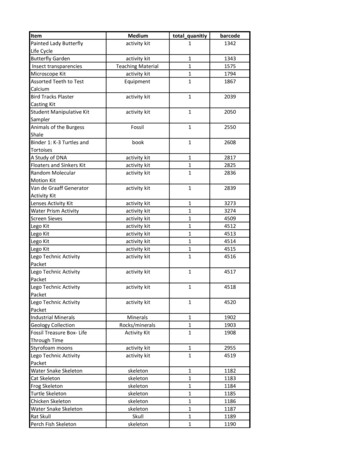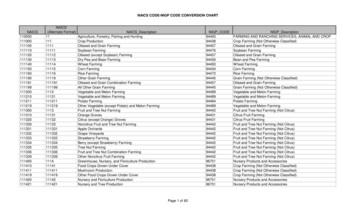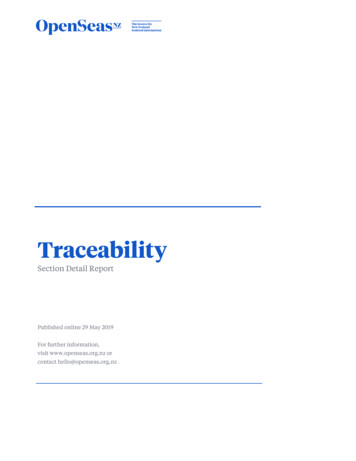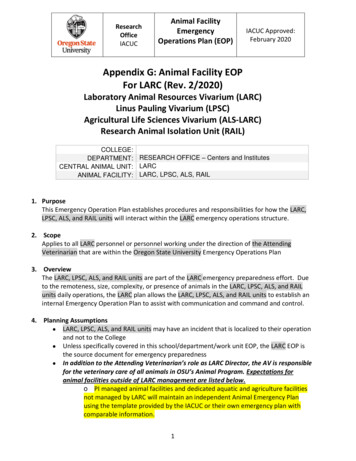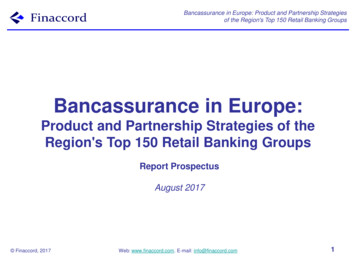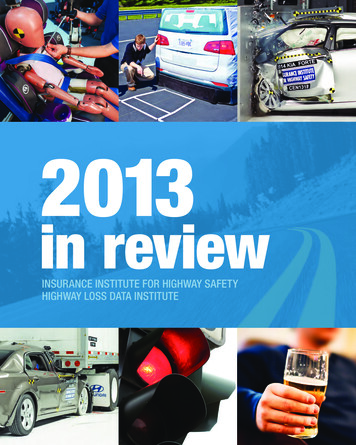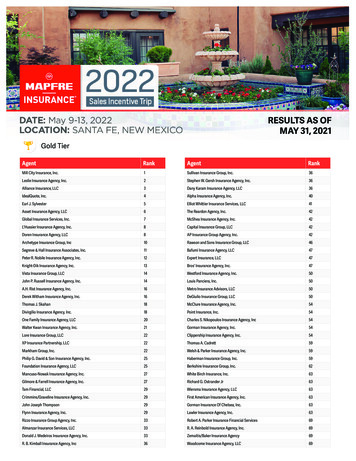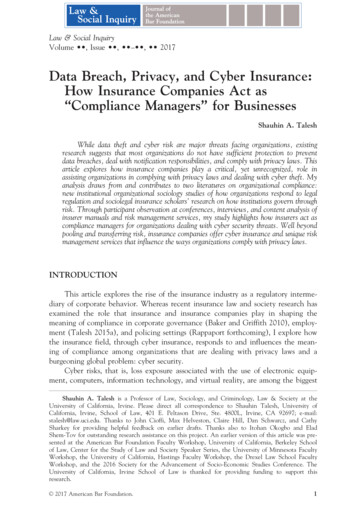
Transcription
НАУЧНИ ТРУДОВЕ НАУНИВЕРСИТЕТ ПО ХРАНИТЕЛНИТЕХНОЛОГИИ - ПЛОВДИВ2017 г.ТОМ 64, КНИЖКА 1SCIENTIFIC WORKS OFUNIVERSITY OF FOODTECHNOLOGIES2017VOLUME 64 ISSUE 1Risk in Animal Insurance in Republic of Macedonia with Special Review toFish InsuranceTrajan Dojcinovski1*, Nikolce Jankulovski1, Katerina Bojkovska1, Goran Mihajlovski11Faculty of Biotechnical Sciences, University “St. Kliment Ohridski“, Bitola, Macedonia*Corresponding author: Trajan Dojcinovski, PhD, Faculty of Biotechnical Sciences, University “St. KlimentOhridski " Bitola, R. Macedonia, e-mail: tdojcinovski@gmail.comAbstractAnimal insurance is quite important because animal husbandry as one of the important industries is exposedto certain risks that can cause major damage. Risks in animal husbandry are the result of percussion, forcedslaughter and danger of an accident.The taking of preventive measures for preventing the occurrence of damages, caused by the risks of theproduction itself, is in the function of saving and protecting the livestock production itself. Compensationfor damage to animals is most often compromised with animal insurance, since the damage caused can bewith far-reaching consequences, not only in the concrete production, but also in the production cycle itself.Unlike other animals, fish insurance is done in fish that are grown in a special technological process inspecially built swimming pools or cages, for damages caused by illness or accident. The risk of an accidentin fish involves poisoning fish, lightning strikes and clogging of inbound canals or grids.Key words: risks in livestock husbandry, need for insurance, general insurance provisions, premium tariff,need for fish insurance and their specificity of insurance.277
НАУЧНИ ТРУДОВЕ НАУНИВЕРСИТЕТ ПО ХРАНИТЕЛНИТЕХНОЛОГИИ - ПЛОВДИВ2017 г.ТОМ 64, КНИЖКА 1Animal insuranceIn animal insurance, the subject of insuranceaccording to the General Conditions of Insuranceare healthy domestic animals, animals that arereared under appropriate zoogenic conditions,which are properly used, and animals with acertain age. Insurance in equidae (horses, masks,mules and donkeys) is done with an age of 10days up to the age of 18 or up to 21 years of age,with continuous insurance of 15 years of age, incattle and buffalo with age from 10 days to 12years or up to 15 years old with uninterrupted 9year-old insurance, in sheep and goats aged 3months to 6 years old, and in pigs aged 21 daysand the smallest weight of 5 kg to 7 years old. Theother types of animals are insured under thespecial conditions for animal insurance(Dojchinovski, 2005).In accordance with the Special conditions foranimal insurance, the animals are insured againstthe dangers of being victimized and forcedslaughter of animals and the risks of an accident.The dangers of being victimized andinvoluntarily slaughtering of animals, involvedeath due to illness or accident, forced slaughterdue to illness or accident, etc. The danger ofaccident include at animal include damages thatcan occur in animals from the risks of fire,lightning, explosion, flood, storm, tramp withvarious vehicles, blow from some objects,damage from mutilation, external injuries fromfalling and slipping, drowning in water and mud,injuries from wild beasts, snake and beating bites,electric shock, accidental heat or freezing,poisoning with chemical poisons, etc.Tariff for animal insurance premiums andapplication of premium ratesThe premium rate of insurance (insurancecoverage) in animals is a sum of premium rates ina type of insurance or in all insurance, carried outby an insurance company, in the case of animalinsurance. The premium for the animal insurancepremium is at the same time a pricelist for theinsurance premium, which determines the priceof the risk of animal insurance. Animal insuranceSCIENTIFIC WORKS OFUNIVERSITY OF FOODTECHNOLOGIES2017VOLUME 64 ISSUE 1tariffs are adopted by insurance companies with aspecial rulebook, which contains the General andSpecial Provisions and Conditions (Principles)for animal insurance premiums, on the basis ofwhich a policy is made and concludes aninsurance contract (Dojchinovski, 2010).In animal insurance, premium rates in theinsurance tariff are classified into 6 groups ofhazards, depending on the type and category ofanimals, of which the five groups of hazards referto insurance of adult animals, while the sixthgroup of hazards applies to Insurance of younganimals. The distribution of animals in theirinsurance in five groups of hazards, is carried outdepending on the size of the risk. For thatpurpose, insurance companies adopt their owncriteria for the classification of the species andcategory of animals. Thus, in the first group ofhazards, with the lowest premium rate, areanimals reared in the best zoohigenic conditions,controlled environment and good veterinaryprotection, while in the fifth, last group of dangerswith the highest premium rate are includedanimals reared in the weakest zoohigenicconditions and with difficulty in treatment. Thesixth group of dangers in animal insurance isapplied in young animals with duration ofinsurance in foals from 10 days to 6 months, incalves from 10 days to 2 months, calves in whitefattening from 10 days to 3 months and in pigletsfrom 21 days and the smallest weight of 5 kg to 2months age.General and special provisions of theanimal insurance premium tariffIn addition to the general provisions of the animalinsurance tariff, in which the general conditionsand principles for the application of insurancepremiums are entered, the insurance companiesalso adopt special provisions of the tariff for theanimal insurance premium with specialregulations, which shall apply to the followingtariff groups and insurance risks: insurance ofanimals from risk of death, forced slaughter orkilling due to illness or accident; Insurance ofanimals from risks during quarantine stay;278
НАУЧНИ ТРУДОВЕ НАУНИВЕРСИТЕТ ПО ХРАНИТЕЛНИТЕХНОЛОГИИ - ПЛОВДИВ2017 г.ТОМ 64, КНИЖКА 1Animal insurance against castration andovariotomy risks; Insurance of animals from risksduring the holding of exhibitions; Insurance ofanimals from risks at a time when they are incollection; Insurance of animals intended forslaughter; Insurance of sheep from dangersickness and accident; Insurance of bees;Insurance of dogs; Insurance of dogs inconnection with vaccination and degelmination;Insurance of exotic animals, inside and outsidezoos; Insurance of male breeding heads from therisk of loss of breeding ability; Insurance ofotters; Bird or chicken insurance; Insuranceagainst risk losing the breeding ability of heifersand cows; Insurance of animals at risk of loss ofcalf and foal during childbirth; Trout insurance;Insurance of carps etc.Insurance of trout (Salmonidae) and carps(Cyprinidae)Fish trout insurance is provided for healthy troutfish, with a minimum length of 10 cm, which aregrown in a special technological process inspecially built swimming pools or cages, fordamages caused by illness or accident. The riskof trotting in trout includes fish poisoning,lightning strikes and clogging of inbound canalsor grids. The damage caused by the escape of thefish, in case of flood and storm, is compensatedwith a special surcharge (Nikolovski & Danev,2001).The sum of insurance for fish trout is differentdepending on the way they are used. Thus, fortrout used for breeding, the amount of insuranceis determined by weight and price per kilogram oflive weight, while in trout while fattening, theamount is determined on the basis of the weightthat will be obtained at the end of fatteninginsurance and the contract price of 1 kg of liveweight or on the basis of the average weight to beobtained at the end of the fodder and the agreedprice. The amount of insurance can t be higherthan the market value of the fish.In this type of insurance, the insured has anobligation to keep accurate records of the date ofplacing trout for fattening or breeding, theSCIENTIFIC WORKS OFUNIVERSITY OF FOODTECHNOLOGIES2017VOLUME 64 ISSUE 1number, length and weight of trout in the objects,daily and monthly loss, number and weight ofsold trout, to indicate the number at the pool orcage, to keep records of the number and weight oftrout (daily and monthly) and the number andweight of the fish removed from the cage or thepool, to keep records of the temperature of thewater and the air, the amount of oxygen, nutritiondata and records for used drugs, treatments andthe performed chemical analysis of the water. Theplace of insurance of trout fish is the buildingwhere the fishes are located. The damage isdetermined by the insured, the insurer and theveterinarian doctor, and by determining thedamage caused, the circumstances under whichthe damage occurred. The damage to the fish isdetermined and liquidated based on the trueweight of the trout on the day of the killing andthe agreed price for 1 kilogram of fish.The premium rate for fish insurance depends onthe achieved technical results of the fishinsurance and applies to the amount of insurance,where the insurance is performed for one year orfor one tour. During the duration of the insuranceof fish from one year the insurance is performedon the average value of the fish. In conditions ofinsurance of fish from risk of escaping fish due toflood, the insurance rate is increased by 20%.The insurance of carp fish (Cyprinidae) is done inhealthy carps (white amur, bighead carp, catfish,etc.) intended for breeding or fattening in thelength of at least 10 cm, grown in fishponds orcages from damages caused by sickness oraccident from poisoning, lightning, clogging ofinlet channels or grids, freezing of water andescaping of fish due to flood or overturning of thecage, if they are insured with an additionalpremium. The amount of insurance for carps shallbe determined on the basis of the weight of thecarps, multiplied by an agreed price of 1 kg of liveweight, where the sum of insurance is calculatedby accounting policies. The insurance of thecarps, depending on the type of damage, starts fordamages from an accident the next day of the dayindicated on the insurance policy, and fordamages from the disease after the expiration ofthe 14th d.279
НАУЧНИ ТРУДОВЕ НАУНИВЕРСИТЕТ ПО ХРАНИТЕЛНИТЕХНОЛОГИИ - ПЛОВДИВSCIENTIFIC WORKS OFUNIVERSITY OF FOODTECHNOLOGIES2017VOLUME 64 ISSUE 12017 г.ТОМ 64, КНИЖКА 1The determination of the damage occurred uponthe application of the insured is performed by theinsurer and the insured, in the presence of aveterinarian, whereby, in the assessment of thedamage, the circumstances for the damage causedare determined. The assessment of damageoccurred in carps is done in two phases, as a preassessment, which includes a detailed descriptionof the damage and a definitive estimate, where thedamage is determined at the time of catching thefish at the end of the insurance. The amount ofdamage in carps is calculated on the basis of theweight of the killed carps and the agreed price.When insuring carps, the insured has anobligation to provide continuous veterinarycontrol of fish, to keep accurate records, fromwhich can be seen the day of placing the plow infattening or breeding, number, length and weightof fish, daily and monthly death, number andweight of fish sold, etc. As with the insurance oftrout fish, when insuring the carps, the insured isobliged to keep a record for marking the pool orcage, number and weight of carps (daily andmonthly), number and weight of removed fishfrom the cage or pool, records for water and airtemperature, amount of oxygen and nutritiondata, required drugs, treatment and chemicalanalysis of the water.Calculation of the insurance premium for carps isinitially done by applying the advance to thepremium, while a definite calculation of thepremium is calculated at the end of the insuranceperiod or production turnaround of the carps. Forcarps, intended for fattening, a flotation premiumis calculated based on accounting policies,whereby the first computational policy calculatesthe total value of the scales by weight, theincrease in carps for 1 month and the price per 1kilogram of live weight. In the followingaccounting policies, the premium is calculated onthe basis of increment. The prize for breedingcarps is calculated according to the agreed weightand price. The amount of premium rates for theinsurance of carps depends on whether the carpsare grown in cages or in open fishing grounds, aswell as from the danger groups. In carpsinsurance, they are divided into four groups ofhazards. Thus, the first group of dangers includescarps grown in a modern building with excellenttechnological process and preventive protection,in the second group of dangers, carps grown in anappropriate facility with registered diseases fromprevious years enter, in the third group ofdangers, a facility that meets the conditions forgrowing fish and where certain diseases havebeen registered in the previous year, while in thefourth group of dangers, are included carps rearedin facilities with average organization of workand the occasional occurrence of certain diseases.Insurance of carps (cyprinides) according to thespecial conditions is done by calculating thepremium rate the first year is carried outaccording to the insurance table, while for thefollowing years it is corrected according to theachieved technical results.ConclusionThe risk in livestock production is a futureuncertainty that occurs as a result of influences ofcertain factors that can cause major damage andadverse economic consequences.The damages that may arise in livestockproduction include: death and involuntaryslaughter and danger of an accident. For thecontinuation of the production process,significant financial means are needed, which canbe provided by compensating the damage bymeans of insurance.The subject of insurance in the animals,according to the General conditions of insurance,are healthy domestic animals, animals that arereared under suitable zoogenic conditions, whichare properly used, as well as animals with acertain age.In animal insurance, premium rates in theinsurance tariff are classified into 6 groups ofhazards, depending on the type and category ofanimals, of which the five groups of hazards referto insurance of adult animals, while the sixthgroup of hazards applies to Insurance of younganimals.Fish insurance shall be performed in healthycarps (white amber, bighead carp, catfish etc.)280
НАУЧНИ ТРУДОВЕ НАУНИВЕРСИТЕТ ПО ХРАНИТЕЛНИТЕХНОЛОГИИ - ПЛОВДИВ2017 г.ТОМ 64, КНИЖКА 1intended for breeding or fattening in the length ofat least 10 cm, grown in fishponds or cages fromdamages caused by disease or accident ofpoisoning, stroke lightning, clogging of feedchannels or grids, freezing of water and escapingof fish, due to flood or overturning of the cage,provided they are insured with an additionalpremium.Despite the need for insurance of livestock andfish, the large and unpredictable risks in livestockproduction that occur in the last years in theRepublic of Macedonia, as well as the highpremium rates, have significantly reduced theinterest of both insurance companies and animalproducers.High premium rates in livestock insurance have adisastrous impact on producers for livestockinsurance.SCIENTIFIC WORKS OFUNIVERSITY OF FOODTECHNOLOGIES2017VOLUME 64 ISSUE 1Njavro, M., M. Vidic (2001). Crop and fruitinsurance in the EU and the US;EuropeanInsuranceCommittee(2002).Committee for Agricultural Risks: Insurance ofAgricultural Risks in Europe. AGR, 2002(06/02), Paris.Harwood. J., R. Neifner, K. Coble, J. Perry, A.Somwaru (1999). Managing Risks in Farming,Concepts, Reserch and Analisys. EconomicReserch Service Report. USDA, WashingtonDC, USA.Organization for Economic Co-operation andDevelopment (OECD) (2000). Income RiskManagement in Agriculture, Peris.ReferencesDojchinovski, T. (2005). Agricultural Insurance,Textbook. Faculty of Tourism and Hospitality,Ohrid, p. 115. [In Macedonian].Dojchinovski T. (2007). Agricultural Insurance,textbook, Faculty of Natural History and Food,Ohrid. [In Macedonian].Dojchinovski, T. (2010). Insurance in Agro-FoodIndustry, Textbook. Faculty of BiotechnicalSciences, Bitola, p. 182. [In Macedonian].Doreva, E. (2000). Agrarian Economics, Facultyof Economics, Skopje. [In Macedonian].Ganchevski, P. (2000). Theory and Practice in theInsurance Business, Mikena, Bitola. [InMacedonian].Jovanovski, T. (1997). Insurance Economics,Euro-Mak Company, Skopje. [In Macedonian].Nikolovski, A., D. Danev (2001). Insurance withElements of Actuarial Analysis, Skopje. [InMacedonian].Milosevic, B. (2009). Assurance of Property andPersons. [In Macedonian].Egumenovski, P. et al. (1998). SpecialAgriculture. Culture, Skopje. [In Macedonian].Insurance Practices for Insurance Companies ADfor Insurance "Macedonia" and AD "Vardar"Skopje. [In Macedonian].281
a type of insurance or in all insurance, carried out by an insurance company, in the case of animal insurance. The premium for the animal insurance premium is at the same time a pricelist for the insurance premium, which determines the price of the risk of animal insurance. Animal insurance tariffs are adopted by insurance companies with a
